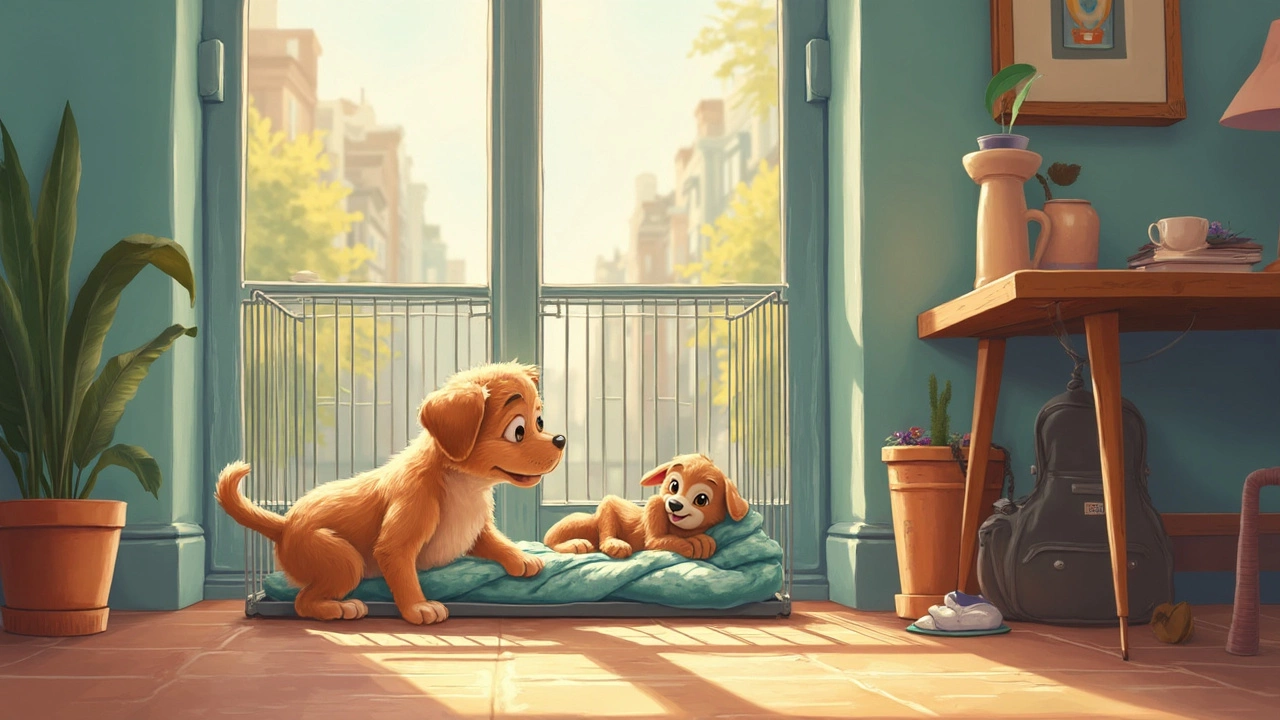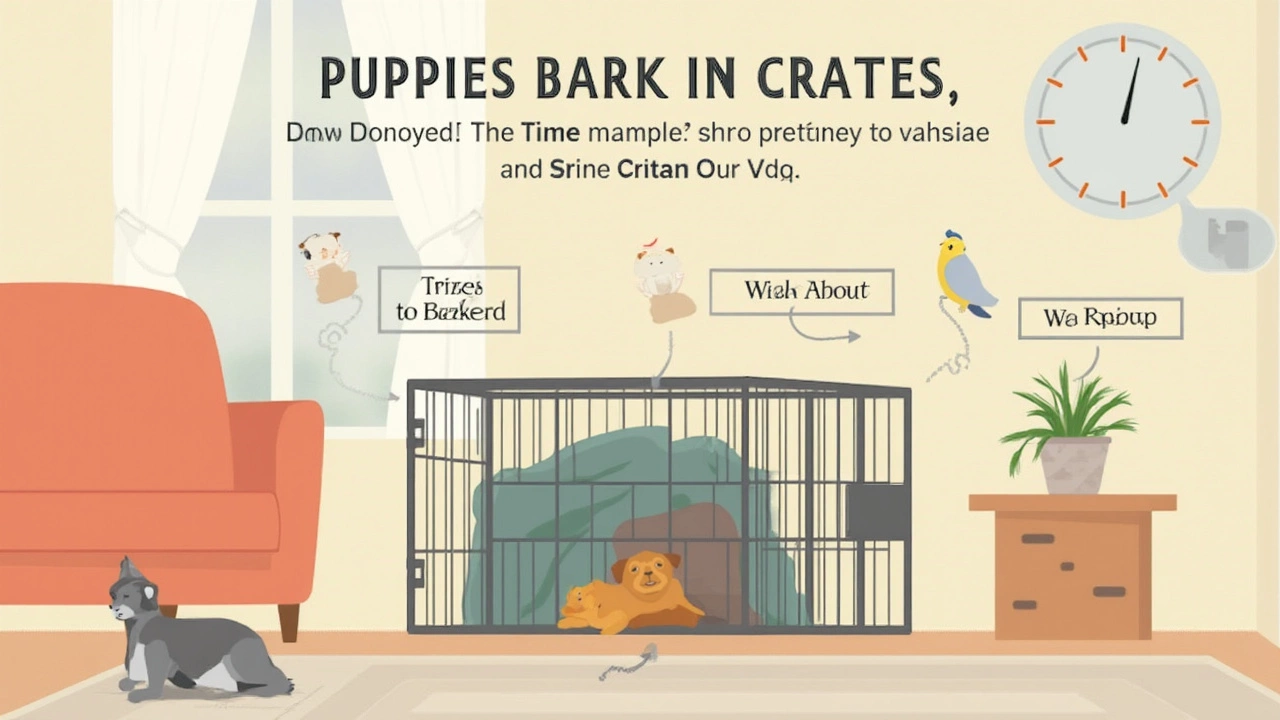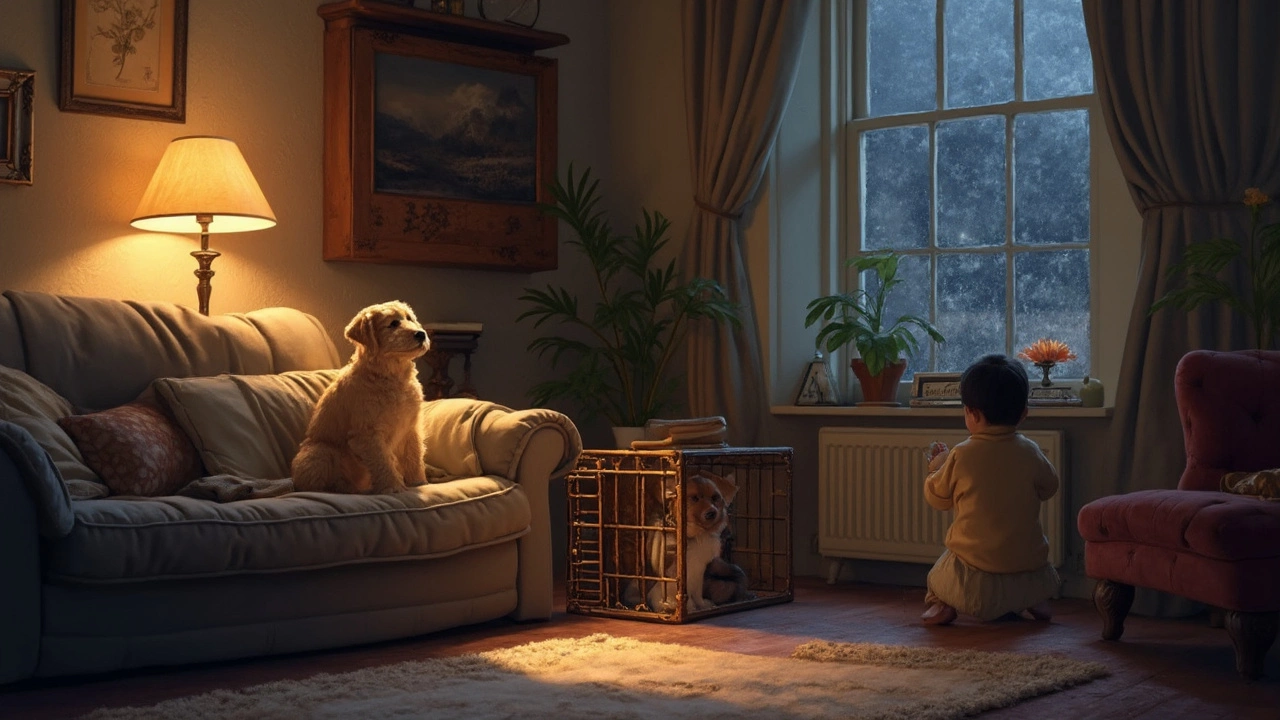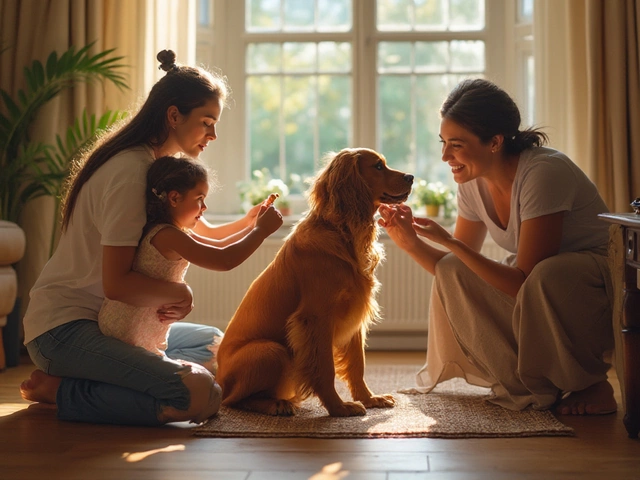If you’ve ever tried crate training a puppy, you know the noise isn’t easy to ignore. Those barks and whines can wear anyone down, especially at 2 AM. Your neighbors might not be thrilled either. The big question: should you let your puppy bark it out, or step in every time?
There’s no one-size-fits-all answer, but ignoring the barking sometimes does more harm than good—especially if your puppy feels anxious or scared. Puppies bark for different reasons: some are just testing limits, while others might need to pee or are scared of being alone. Tuning out every bark can make them feel abandoned, or turn crate time into a battleground.
But don’t rush to rescue them every time either. If your pup learns that barking gets him out of the crate or brings a visit from you, he’ll probably just keep at it. The trick? Figure out why your puppy is barking. Is he bored, scared, or just wants attention? Getting this right makes all the difference, and can save you a lot of sleepless nights.
- Why Puppies Bark in the Crate
- What Happens If You Ignore It
- When You Should Intervene
- Training Tips That Actually Work
- Handling Setbacks and Bad Nights
Why Puppies Bark in the Crate
Puppies use barking to get your attention, share their feelings, or just tell you what’s up. When they’re in a crate, it’s even more noticeable because there’s nowhere else for them to go. Most crate barking falls into a few common categories.
- Separation Anxiety: Many puppies haven’t been away from their litter before, so suddenly being alone in a crate is a big deal. Their barking often means, “Hey, where did everybody go?”
- Needing the Bathroom: Little puppies have tiny bladders. If they’re barking like crazy and it’s been a few hours since their last potty break, they probably aren’t faking it.
- Boredom or Too Much Energy: If your pup hasn’t had enough playtime, the crate can feel like a timeout. Barking might be their way of saying they’re wound up and ready to roll.
- Fear or Unfamiliar Surroundings: New smells, noises, or even the crate itself can spook a puppy. Unfamiliar stuff sets off a lot of yapping, especially the first few nights.
- Attention Seeking: Sometimes, puppies figure out barking means someone will come running. Smart little guys, right?
According to a 2023 puppy behavior survey by the American Kennel Club, over 60% of new puppy owners reported that their pups barked more during crate training than at any other time in the day.
| Reason | How Often Owners Report It |
|---|---|
| Separation Anxious | 48% |
| Needs Bathroom | 22% |
| Bored/Energetic | 16% |
| Scared/New Environment | 10% |
| Attention Seeking | 4% |
Understanding why the barking happens is step one. It lets you pick the right solution, instead of just hoping your puppy will outgrow it. If you jump to ignoring the noise before figuring out the reason, you could miss something important—or make crate training even tougher for both of you.
What Happens If You Ignore It
Let’s get straight to the point—ignoring puppy barking in the crate can go a couple different ways. Sometimes, ignoring works. Puppies get bored when nobody reacts and might stop barking after a few nights. But for other pups, ignoring can ramp things up, turning a bit of whining into an all-night barkfest.
The idea behind ignoring is “don’t reward bad behavior.” If you rush to your puppy every time he makes a sound, he quickly learns that barking equals attention. That pattern can get locked in fast, and suddenly you’re stuck with a noisy habit that’s tough to break.
But here’s the downside. If your puppy is genuinely scared, stressed, or needs something (like a bathroom break), getting ignored can make crate training way harder. Young puppies especially don’t have big bladders—they physically can’t hold it all night. Ignoring barks in those cases leads to accidents, more stress, and even fear of the crate.
Most dog trainers say it’s about balance. For little pups under 16 weeks, expect them to need out every 2-4 hours at night. If your puppy’s had a potty break, is safely tucked in, and you’re sure he’s not hungry, tired, or sick, it’s safer to ignore a bit of “drama barking.” But constant, frantic, or panicked noise is a different story—those are red flags.
- If barking grows more intense or frantic the longer you ignore it, your puppy may be anxious—not just stubborn.
- Barking that comes with pacing, drooling, or biting the crate bars can point to stress or even separation anxiety.
- Usual whining right after you first close the crate door usually means “I just don’t like this.” That often fades in a few days, especially if you don’t give in right away.
Here’s a handy way to track your situation:
| Behavior | What It Might Mean | Ignore or Intervene? |
|---|---|---|
| Whining/panting soon after crate time | Protest or adjusting | Usually ignore, give it a few minutes |
| Barking with real panic or physical distress | Anxiety/fear | Intervene, change routine |
| Short bursts or puppy "complaints" | Attention-seeking | Try to ignore unless it escalates |
| Long, frantic barking after potty, food, comfort | Possible crate aversion | See a trainer, rethink method |
Ignoring barking is never a one-size-fits-all solution. It helps to keep a training journal or just jot down a few notes each night. That way, you start to spot patterns and figure out if your puppy is testing you or truly in distress. Trust your gut. If something feels off, it’s okay to take a break and reset before crate time spirals out of control.

When You Should Intervene
It’s easy to say, “Just ignore it.” But sometimes, you really shouldn’t. Figuring out the right time to help your puppy isn’t just about peace and quiet—it’s about making sure they’re safe and not feeling totally abandoned. Here are the big red flags:
- Bathroom Needs: Young puppies, especially under four months, have tiny bladders. If your pup starts barking in the crate soon after you put him in, he might actually need to pee or poop. At night, the average eight-week-old puppy can only hold it for about two to three hours. Ignoring real bathroom signals can make crate training way harder by causing accidents and making your pup anxious.
- Pain or Discomfort: Listen for sudden changes—a new, sharp kind of barking, yelping, or signs of distress. Maybe your puppy’s paw is caught, or he’s injured himself. Always check if your puppy sounds truly panicked or something is wrong in the crate.
- Separation Panic: Some puppies experience serious anxiety when left alone, called separation distress. If your puppy is panting, drooling, trembling, or won’t settle at all (beyond just barking), you might need to reset your crate training plan. Forcing it can make things worse.
Knowing your puppy helps. Keep an ear out for the difference between normal “I want out” barking and the high-pitched, nonstop yelping that comes from panic or discomfort. New puppies often get better with a steady routine, but ignoring true distress doesn’t teach them to soothe—it just makes them fear the crate.
If you’re seeing repeated trouble, try going back a few steps in the training process. Instead of toughing it out, make crate time fun again—use chew toys, treats, and short practice sessions. Sometimes the “cry it out” method backfires, especially with sensitive breeds. And don’t forget: puppies are individuals. What works for a neighbor’s Lab might be misery for your little terrier.
| Age | Max Hours in Crate |
|---|---|
| 8 weeks | 2-3 |
| 12 weeks | 3-4 |
| 16 weeks | 4-5 |
If your puppy has been alone longer than the max hours listed above, it’s time for a bathroom break. The bottom line: ignore attention-seeking barks, but never ignore signs that your puppy is in trouble. That's how you keep crate training on track while making sure your puppy feels safe and cared for.
Training Tips That Actually Work
When it comes to stopping puppy barking in the crate, structure beats guesswork every time. You want your pup to see the crate as a safe spot, not a punishment zone. Here’s how to actually calm the noise and set healthy habits for the long haul.
- Make the crate positive: Get your puppy used to the crate when things are calm. Feed meals in there, toss special toys or treats inside, and throw in a cozy blanket. If the crate is always tied to something good, your pup will chill out faster.
- Start slow: Don’t force your puppy to stay in the crate right away for hours on end. Let him go in and out, close the door for a minute, and then work your way up. Most pups handle short, happy crate sessions much better. A few five-minute sessions a day can do wonders in the first week.
- Ignore attention-seeking barks: This one’s tough, but dogs are smart. If barking gets them out of the crate, they’ll do it again. But if they realize barking doesn’t work, they’ll stop. Only let your puppy out when he’s quiet. Even a short pause in barking before you open the crate teaches him it pays to chill.
- Handle potty breaks right: Some puppies bark because they really do need to go out. Stick to a potty schedule—take them out every couple of hours, and right before bedtime. If you’re not sure if he needs to pee or just wants attention, quietly let him out for a quick potty trip and pop him back in with zero fuss.
- Tire them out: Puppies with extra energy are more likely to kick up a fuss in the crate. Get in good play or a solid walk so your pup is ready to nap instead of scream.
You might hear advice about crate covers or calming sprays. Both can help, but try them along with these basics, not instead. And here’s a quick peek at why training matters:
| Method | Success rate |
|---|---|
| Gradual crate training | Up to 85% report less barking in a week |
| Ignoring barking completely | Only 50% see improvement (can create anxiety) |
Consistency matters most. The more predictable you are, the faster your puppy will get it. Stick to your guns, keep cool (even when the barking hurts your ears), and soon your nights will be a lot quieter.

Handling Setbacks and Bad Nights
Crate training isn’t a smooth ride for most folks. One night your pup crashes right away, and the next you’re both up listening to a barking marathon. Setbacks are totally normal, especially in the first couple of weeks. Puppies test boundaries hard, and just when you think you’ve cracked the code, something throws things off—maybe a thunderstorm, teething, or just a stubborn mood.
The key: don’t panic or get mad at your puppy. Regression happens. According to a 2023 survey from the American Veterinary Society of Animal Behavior, about 60% of new puppy owners face at least one bad crate night a week during the first month. Consistency is your best friend, even on rough nights. If you break your routine and let your puppy out every time they bark, they’ll quickly learn barking equals freedom. That sets training back fast.
Here’s how you can handle rough nights without losing your mind:
- Stick with the basics. Do the same bedtime routine every night. Feed, potty break, calm time, then into the crate.
- Stay calm. If you need to step in, keep it boring. Go in, use a soft voice, don’t play. Quick check, back to the crate.
- Check the environment. Make sure the crate isn’t too hot, cold, or noisy. Sometimes minor tweaks like a fan or white noise machine help.
- Double-check for real needs. Sometimes a puppy genuinely does need to pee—even if it's the third time. Younger pups (<16 weeks) usually need to go out once or twice at night.
- Try a safe chew toy or comfort item for them to gnaw on. Don’t give in to every bark, but be ready to troubleshoot if nothing else calms them down.
If setbacks start stacking up, it’s worth tracking the pattern. Here’s a quick look at common puppy wakeups in a typical first month:
| Week | Avg. Wakeups/Night |
|---|---|
| 1 | 2-3 |
| 2 | 2 |
| 3 | 1-2 |
| 4 | 1 |
This table isn’t a magic rule, but it helps set realistic expectations. Progress isn’t just about fewer wakeups—it’s about your pup feeling safer in the crate, even when things get noisy.
One last thing: never punish your puppy for barking. Negative responses just build fear around the crate and can make the puppy barking worse. Stick with it, reward calm, and remember, most puppies settle with time and consistency—even after a bad night.







